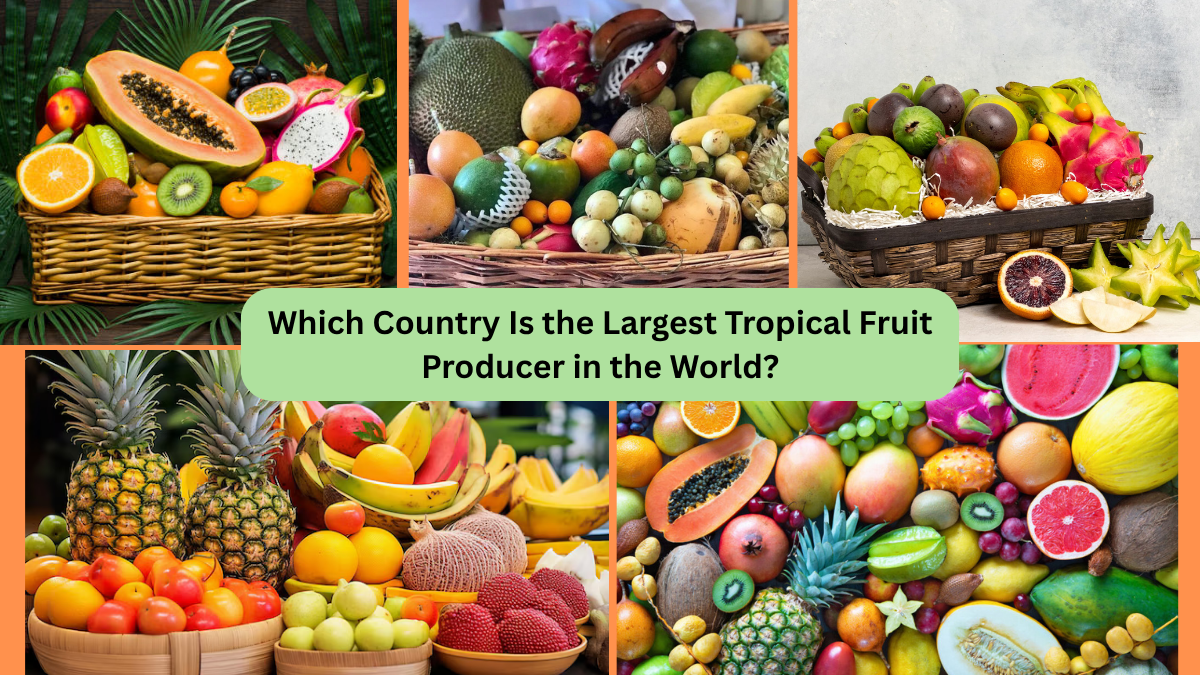Tropical fruits are nature’s vibrant, sweet treasures — rich in color, taste, and nutrients. From bananas and mangoes to pineapples, papayas, and guavas, these fruits are grown in warm, humid climates and are enjoyed around the world. The demand for tropical fruits has surged in recent decades, thanks to their exotic flavors, health benefits, and use in juices, desserts, smoothies, and traditional dishes.
But which country leads the world in producing these delicious fruits? Let’s dive into the fascinating world of tropical agriculture and uncover the global leader in tropical fruit production.
What Are Tropical Fruits?

Tropical fruits are fruits that grow in hot, humid environments typically found in regions near the equator. These fruits thrive in temperatures above 18°C (64°F) year-round, with high rainfall and rich, fertile soils.
Popular tropical fruits include:
- Bananas
- Mangoes
- Pineapples
- Papayas
- Guavas
- Lychees
- Rambutans
- Mangosteens
- Durian
- Jackfruit
- Passion fruit
They’re valued for their sweetness, distinct aromas, juicy flesh, and impressive nutritional benefits — often packed with vitamin C, fiber, antioxidants, and essential minerals.
Global Importance of Tropical Fruits
Tropical fruits are a vital part of both domestic diets and international trade. Globally, their consumption has increased due to:
- Growing health awareness
- Rising demand for fresh, natural foods
- The popularity of exotic fruit smoothies, fruit bowls, and juices
- Expanding culinary diversity in international cuisines
According to the Food and Agriculture Organization (FAO), tropical fruits contribute significantly to the economies of many countries, providing employment and export income while supporting millions of smallholder farmers.
India: The Largest Tropical Fruit Producer in the World

India holds the title of the largest tropical fruit producer in the world. The country’s vast, fertile lands, diverse climatic conditions, and centuries-old farming traditions make it a global powerhouse for tropical fruit cultivation.
Production Statistics
According to FAO data and national agricultural reports, India produces over 100 million metric tons of fruits annually, a significant portion of which are tropical varieties.
India leads global production in:
- Mangoes (accounting for nearly 40% of the world’s supply)
- Bananas (among the top producers)
- Papayas
- Guavas
- Jackfruit
India’s mango production alone exceeds 20 million metric tons per year, making it synonymous with this beloved tropical fruit.
Why Is India So Dominant in Tropical Fruit Production?
Several factors contribute to India’s leadership in tropical fruit farming:
Diverse Climatic Zones
India’s geographical diversity — ranging from tropical rainforests in the south to subtropical regions in the north — provides ideal growing conditions for a wide variety of fruits.
Large Farming Community
With millions of small-scale and commercial farmers involved in horticulture, India boasts one of the world’s most extensive fruit cultivation networks.
Rising Domestic and Export Demand
India’s large population ensures consistent domestic consumption of tropical fruits. Additionally, demand for Indian mangoes, guavas, and papayas continues to grow in Europe, the Middle East, the U.S., and Southeast Asia.
Government Support
The Indian government promotes horticultural development through programs like the National Horticulture Mission (NHM), offering subsidies, research support, and modern agricultural practices.
China: A Close Contender

China ranks as the second-largest producer of tropical and subtropical fruits. The country produces substantial quantities of:
- Bananas
- Lychees
- Longans
- Pineapples
- Mangoes
Southern Chinese provinces like Guangxi, Guangdong, Hainan, and Yunnan have ideal climates for tropical fruit cultivation.
Production Highlights
China produces over 70 million metric tons of fruit annually, with a rapidly growing tropical fruit sector due to increasing domestic demand and advanced farming technology.
Indonesia, Brazil, and the Philippines: Major Contributors
Several other countries play significant roles in the global tropical fruit market:
Indonesia
Indonesia is one of the top banana and mango producers globally, along with significant jackfruit, papaya, and durian harvests. The country’s tropical islands provide year-round fruit-growing conditions.
Brazil
Brazil’s Amazon and tropical regions produce vast quantities of:
- Bananas
- Papayas
- Pineapples
- Açaí berries
Brazil is a major supplier to South American markets and a growing exporter to Europe and the U.S.
Philippines
The Philippines is a top global banana and pineapple exporter. It supplies fresh and processed fruits to:
- Japan
- South Korea
- Middle East
- China
Key Tropical Fruits and Their Top Producers

Let’s look at specific tropical fruits and their major producers:
| Fruit | Top Producers |
|---|---|
| Mango | India, China, Indonesia, Mexico |
| Banana | India, China, Philippines, Indonesia, Brazil |
| Pineapple | Philippines, Thailand, Indonesia, India, Brazil |
| Papaya | India, Indonesia, Nigeria, Brazil |
| Guava | India, Thailand, Indonesia |
| Lychee | China, India, Vietnam |
Tropical Fruit Market Trends
As global tastes evolve, the tropical fruit market is experiencing exciting shifts:
Health and Wellness Focus
Consumers are seeking fruits high in vitamins, fiber, and antioxidants — making tropical fruits increasingly popular in health-focused diets and wellness products.
Juices, Smoothies, and Superfoods
Tropical fruits are key ingredients in juices, acai bowls, smoothie blends, and plant-based yogurts.
Growth in Export Markets
Countries like India, the Philippines, and Vietnam are expanding their reach to North America, Europe, and the Middle East, driven by rising global demand for exotic fresh fruits.
Challenges in Tropical Fruit Production

Despite its growth, the tropical fruit sector faces challenges:
Climate Change
Shifts in rainfall patterns and temperatures threaten tropical fruit yields, especially for water-sensitive crops like bananas and mangoes.
Pests and Diseases
Fruits like bananas are vulnerable to pests and diseases like Panama disease, affecting global supplies.
Market Fluctuations
Price volatility due to export restrictions, weather disruptions, and market demand changes impacts growers’ incomes and global fruit availability.
The Future of Tropical Fruit Production
The future looks promising for tropical fruit growers, with trends pointing toward:
- Increased demand for organic and sustainably farmed tropical fruits
- Rising consumption in Asia-Pacific, North America, and Europe
- Growth in processed fruit products (juices, frozen fruits, purees)
- Enhanced disease-resistant fruit varieties through agricultural innovation
India is expected to maintain its dominant position, followed closely by China, the Philippines, and Indonesia.
Final Thoughts
Which country is the largest tropical fruit producer in the world? The clear answer is India. With its ideal growing conditions, rich agricultural history, and vast production volumes of mangoes, bananas, guavas, papayas, and jackfruit, India leads the global tropical fruit market by a substantial margin.
As health-conscious consumers worldwide increasingly embrace tropical flavors and superfoods, the demand for these vibrant fruits is only set to grow — ensuring India and its tropical counterparts remain key players in global horticulture.





